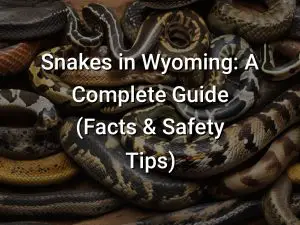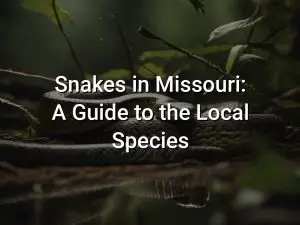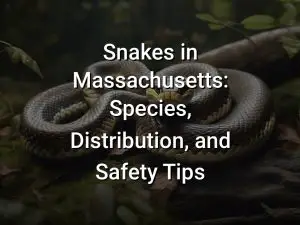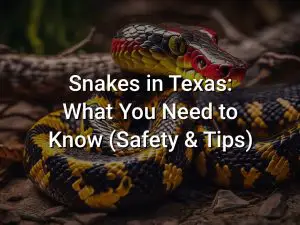Snakes in Maine: What You Need to Know (2023 Update)
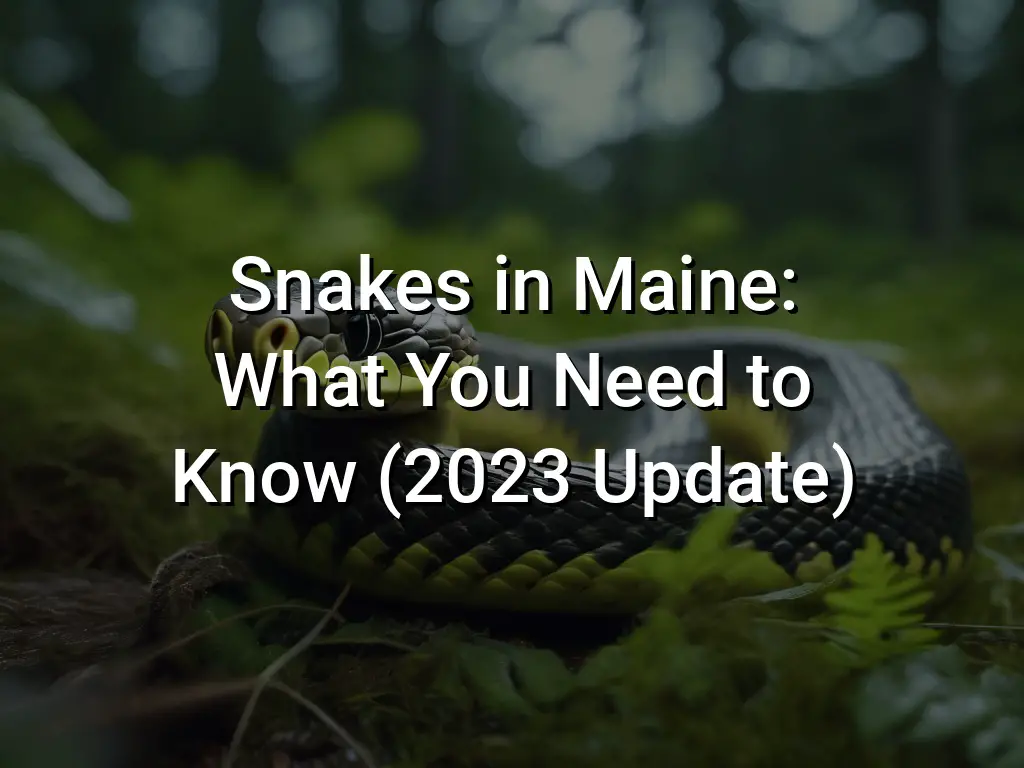
Are you ready to explore the fascinating world of snakes in Maine? Whether you’re a snake enthusiast or just curious about these slithery creatures, we’ve got all the information you need. From the types of snakes found in Maine, their habitat and behavior, to snakebite prevention and educational programs, this 2023 update has you covered.
Maine may not be the first place that comes to mind when you think of snakes, but the state is home to several species, both venomous and non-venomous. We’ll delve into their unique characteristics, their role in natural pest control, and the conservation efforts to protect these fascinating reptiles. So get ready to learn, explore, and gain a deeper appreciation for the snakes of Maine.
Quick Links
Types of Snakes Found in Maine
Maine is home to a variety of snake species, each with its own unique characteristics. Here are some of the types of snakes you may encounter in Maine:
- Eastern Garter Snake: This is one of the most common snakes in Maine. It has a long and slender body with distinctive lateral stripes running along its length.
- Northern Water Snake: This snake is often found near bodies of water such as rivers, ponds, and marshes. It has a thick body and dark markings on its back.
- Eastern Milk Snake: Milk snakes are known for their vibrant colors and patterned scales. They can be found in forested areas and are relatively harmless to humans.
- Eastern Rat Snake: Rat snakes are large and non-venomous. They are excellent climbers and are most commonly found in wooded areas.
- Timber Rattlesnake: This is the only venomous snake species in Maine. Timber rattlesnakes have a distinctive rattle on their tails and are primarily found in the southwestern part of the state.
It’s important to note that while snakes can be fascinating creatures, it’s best to observe them from a safe distance and avoid disturbing their natural habitat.
Habitat of Maine Snakes
Maine is home to a diverse range of snake species, each with its own preferred habitat. Understanding their habitat preferences is crucial for snake enthusiasts and those living in snake-prone areas to coexist peacefully with these reptiles.
Maine snakes can be found in a variety of habitats, including forests, wetlands, grasslands, and rocky areas. Some species prefer forested areas with dense vegetation, such as the Eastern Garter Snake and the Northern Ringneck Snake. These snakes can often be found under logs or in leaf litter.
Wetland habitats are also popular among Maine snakes, with species like the Common Watersnake and the Northern Water Snake frequently found near rivers, ponds, and marshes. These snakes are excellent swimmers and are known to feed on fish, frogs, and other aquatic prey.
Grasslands and meadows are preferred habitats for snakes like the Eastern Milk Snake and the Eastern Hognose Snake. These snakes can often be found basking in the sun or burrowing in the soil. They feed on small mammals, birds, and sometimes even other snakes.
Rocky areas, such as cliffs and outcroppings, provide suitable habitats for snakes like the Eastern Ratsnake and the Northern Copperhead. These snakes are excellent climbers and are often seen basking on rocks or hiding in crevices.
It’s important to note that snakes are ectothermic, meaning their body temperature is regulated by their environment. They rely on external heat sources, such as the sun or warm rocks, to raise their body temperature. This is why you may often find snakes basking in sunny areas.
By understanding the habitat preferences of Maine snakes and being aware of their behavior, it is possible to peacefully coexist with these fascinating creatures and appreciate their ecological role in the ecosystem.
Venomous Snakes in Maine
Maine is home to two venomous snake species: the timber rattlesnake and the northern copperhead. Although encounters with venomous snakes are rare, it’s important to be aware of their presence and take precautions when exploring snake habitats.
The timber rattlesnake, also known as the canebrake rattlesnake, is the only venomous snake species native to Maine. It is a large and heavy-bodied snake, typically ranging from 3 to 5 feet in length. The timber rattlesnake is characterized by its distinct rattling noise, which it produces by vibrating its tail when threatened.
The northern copperhead is a venomous snake species that is rare in Maine but can occasionally be found in the southern part of the state. It is a medium-sized snake, typically measuring between 2 and 3 feet in length. The northern copperhead is known for its copper-colored head and hourglass-shaped markings along its body.
If you come across a timber rattlesnake or northern copperhead, it is important to keep your distance and avoid any attempts to handle or provoke the snake. Give them space and slowly back away to allow them to move away on their own. It is important to remember that snakes play a crucial role in Maine’s ecosystems and should be respected and admired from a safe distance.
If you are bitten by a venomous snake, seek immediate medical attention. Do not attempt to suck out the venom or apply a tourniquet. Stay calm and try to keep the affected limb immobilized while waiting for medical professionals to arrive. It is important to provide accurate information about the snake species involved in the bite to ensure appropriate treatment.
Remember, most snake species in Maine are non-venomous and pose no threat to humans. By educating yourself and taking basic precautions, you can coexist safely with snakes and appreciate their important role in the ecosystem.
Non-Venomous Snakes in Maine
Maine is home to several species of non-venomous snakes that play important roles in the state’s ecosystem. These snakes are harmless to humans and are beneficial for controlling populations of pests such as rodents and insects.
1. Garter Snake: Garter snakes are the most common snakes found in Maine. They have long, slender bodies with distinctive stripes running along their back. Garter snakes are excellent climbers and are known for their ability to release a foul-smelling musk when threatened.
2. Rat Snake: Rat snakes are large, non-venomous snakes that are skilled climbers and excellent hunters. They are known for their prowess in controlling rat populations, hence their name. Rat snakes have a pattern of dark blotches against a lighter background.
3. Milk Snake: Milk snakes are often mistaken for venomous coral snakes due to their similar coloration. They have vibrant red, black, and yellow bands or blotches. Milk snakes are known for their diet of small mammals and their ability to climb trees.
4. Worm Snake: Worm snakes are small, burrowing snakes that feed primarily on earthworms and small invertebrates. They have smooth, glossy scales and a pinkish or reddish-brown coloration. Worm snakes are rarely seen and spend most of their time underground.
5. Smooth Green Snake: Smooth green snakes are slender, bright green snakes with smooth scales. They are excellent climbers and are often found in grassy areas, where they feed on insects and spiders. Smooth green snakes are considered a species of special concern in Maine.
It is important to note that although these snakes are non-venomous, they may bite if they feel threatened. However, their bites are typically harmless and cause only minor discomfort. As with all wildlife, it is best to observe snakes from a safe distance and avoid disturbing their habitat.
By understanding and appreciating the role of these non-venomous snakes in Maine’s ecosystem, we can foster coexistence with these fascinating and beneficial creatures.
Behavior and Diet of Maine Snakes
Maine is home to a variety of snake species, each with its own unique behavior and diet. Understanding the behavior and diet of Maine snakes can help dispel any fears or misconceptions and promote coexistence with these important creatures.
Snakes in Maine are ectothermic, meaning they rely on external sources of heat to regulate their body temperature. This is why they are commonly found basking in the sun or seeking shelter in warm areas. Snakes are most active during the warmer months, from spring to fall, when temperatures are favorable for their metabolism.
Maine snakes have different diets depending on their species and size. Common snake prey includes small mammals, such as mice and voles, birds, frogs, and insects. Snakes are opportunistic feeders, relying on their ability to swallow prey whole. They have specialized jaws that can stretch to accommodate larger meals.
Contrary to popular belief, snakes are not aggressive creatures and will generally only bite if they feel threatened or cornered. Most snake bites occur when humans accidentally step on or attempt to handle a snake. It’s important to give snakes their space and observe them from a safe distance.
Snakes play a crucial role in the ecosystem, primarily as predators. They help control populations of rodents and other small animals, balancing the ecosystem and preventing overpopulation. By keeping these populations in check, snakes contribute to a healthier and more balanced environment.
It’s important to remember that snakes are protected wildlife in Maine and should not be harmed or killed. If you encounter a snake in your outdoor space, it’s best to leave it alone and let it continue on its way. If you have concerns about snakes in your immediate vicinity, contacting a local wildlife expert or removal service can provide guidance on safe and humane options.
By understanding the behavior and diet of Maine snakes, we can coexist with these fascinating creatures and appreciate the important role they play in our ecosystem.
Snakes as a Natural Pest Control
Snakes play an important role in maintaining ecological balance by acting as natural pest control agents. They help keep populations of rodents, insects, and other small animals in check, reducing the risk of agricultural damage and the spread of diseases.
One of the main prey items for snakes are rodents such as mice and rats. These pests can cause significant damage to crops and transmit diseases to humans and livestock. Snakes help control their population by hunting and consuming them, keeping their numbers at manageable levels.
In addition to rodents, snakes also feed on insects. Many species of snakes are skilled hunters and consume a variety of insects, including spiders, beetles, and grasshoppers. This helps control insect populations that can damage crops and gardens.
Snakes are also efficient predators of small vertebrates such as amphibians and small birds. By keeping these populations in balance, they help maintain the overall health and diversity of ecosystems.
It is important to note that not all snakes are effective pest control agents. Some snakes may prey on beneficial animals such as songbirds or other non-pest species. Additionally, snakes should not be a substitute for proper pest management practices, such as maintaining cleanliness and preventing access to food sources.
Overall, snakes play a vital role in natural ecosystems as natural pest control agents. By keeping populations of rodents, insects, and other small animals in balance, they contribute to the overall health and sustainability of ecosystems.
Conservation of Maine Snakes
The conservation of Maine snakes is a crucial effort to protect and preserve the diverse snake species found in the state. Many snakes in Maine are facing threats to their populations due to habitat loss, road mortality, and human persecution.
One of the main conservation strategies for Maine snakes is the preservation and restoration of their natural habitats. This includes protecting and maintaining suitable nesting sites, hibernation sites, and foraging areas. Conservation organizations and government agencies work together to identify and prioritize areas for habitat conservation.
In addition to habitat conservation, educating the public about snakes and their importance in the ecosystem is an essential part of snake conservation efforts. Dispelling myths and misconceptions about snakes can help reduce fear and promote coexistence. Educational programs and outreach initiatives aim to raise awareness about the role of snakes in controlling rodent populations and maintaining a healthy ecosystem.
Conservation efforts also include monitoring and research to better understand snake populations, behavior, and habitat requirements. This information helps inform management and conservation strategies for Maine snakes. Researchers study snake populations, conduct surveys, and collect data to assess the health and status of snake species.
Furthermore, establishing protected areas and wildlife corridors is crucial for the long-term conservation of Maine snakes. These designated areas provide safe havens for snakes and other wildlife, allowing them to thrive and maintain healthy populations. It also helps reduce the effects of fragmentation and habitat loss.
Lastly, the enforcement of laws and regulations that protect snakes is essential for their conservation. Maine has laws in place to protect several snake species, including the endangered timber rattlesnake, and illegal collection or harassment of snakes is prohibited. Law enforcement agencies work closely with conservation organizations to enforce these laws and ensure the safety of snakes.
By combining habitat conservation, education, research, protected areas, and enforcement, the conservation efforts in Maine aim to protect and preserve the rich diversity of snake species for future generations.
Snakebite Prevention and Safety Tips
When it comes to snakes, prevention is key. By taking certain precautions and following safety tips, you can minimize the risk of snakebites. Here are some important snakebite prevention and safety tips:
- Stay on designated trails and paths when hiking or exploring the outdoors. Avoid walking through tall grass, brush, or rocky areas where snakes may be hiding.
- Wear sturdy boots and long pants to protect your legs and ankles from potential snakebites.
- Use a walking stick or trekking pole to probe the ground ahead of you, especially in areas with low visibility or dense vegetation.
- Be cautious around log piles, rock formations, and other potential hiding spots for snakes. Always check your surroundings before sitting or stepping over these objects.
- Avoid reaching into dark or concealed areas without first identifying any potential snake presence.
- Be aware of your surroundings and listen for any rustling sounds or warning signs of snake activity, such as hissing or rattling.
- If you encounter a snake, maintain a safe distance and do not attempt to touch or handle it. Most snake bites occur when people try to capture or kill snakes.
- Teach children about snake safety and the importance of not approaching or provoking snakes. Supervise children during outdoor activities to ensure they follow snakebite prevention guidelines.
- If you have a snake on your property or in your house, contact a professional snake removal service for safe and humane removal.
- In the event of a snakebite, remain calm and seek medical attention immediately. Do not attempt to treat the snakebite with home remedies or suction devices.
By following these snakebite prevention and safety tips, you can enjoy the outdoors while minimizing the risk of snake encounters and potential snakebites.
Snake Removal and Encounters
Encountering a snake can be a surprising and sometimes alarming experience, but it’s important to remember that most snakes in Maine are harmless and play important roles in the ecosystem. Here are some tips for dealing with snake encounters and safely removing snakes from your property:
Stay calm: The first step when encountering a snake is to stay calm. Most snakes are not aggressive and will not pose a threat if left undisturbed. Avoid making sudden movements or loud noises that could startle the snake.
Keep your distance: It’s important to maintain a safe distance from the snake. Snakes have a striking range that can vary depending on the species, so it’s best to stay at least a few feet away.
Identify the snake: If possible, try to identify the snake from a safe distance. Take note of its color, pattern, and any distinguishing features. This information can be helpful if you need to contact a wildlife expert for assistance.
Do not handle the snake: Unless you are trained in snake handling, it’s best to avoid trying to pick up or handle the snake yourself. Even non-venomous snakes can bite if they feel threatened.
Call a professional: If you are unsure about the species of snake or if you are uncomfortable dealing with the snake yourself, it’s best to contact a professional wildlife removal service. They have the knowledge and equipment to safely remove the snake from your property.
Prevent future encounters: To reduce the likelihood of future snake encounters, take steps to make your property less attractive to snakes. Clear away any tall grass or debris that could provide hiding spots for snakes. Seal up any gaps or cracks in your home’s foundation to prevent snakes from entering.
Remember, snakes play an important role in the ecosystem and help control rodent populations. It’s generally best to leave them alone and appreciate them from a safe distance. If you have any concerns or questions about snakes in your area, reach out to local wildlife authorities for guidance.
Educational Programs about Maine Snakes
Educational programs about Maine snakes are a valuable resource for learning more about these fascinating creatures and their importance in the ecosystem. These programs are designed to educate people of all ages about the different types of snakes found in Maine, their habitats, behavior, and conservation efforts.
Many nature centers, wildlife organizations, and parks in Maine offer educational programs specifically focused on snakes. These programs often include presentations, interactive exhibits, and guided tours that allow participants to observe snakes in their natural habitat.
During these educational programs, participants can learn about the various types of snakes found in Maine, including both venomous and non-venomous species. Experts provide information on snake identification, characteristics, and habits, helping to dispel common myths and misconceptions about these misunderstood creatures.
Participants also have the opportunity to see live snakes up close, either through demonstrations or in specially designed snake exhibits. Educators explain snake anatomy, behavior, and diet, providing a deeper understanding of their role in the ecosystem.
These programs often emphasize the importance of snake conservation and the role that individuals can play in protecting these creatures and their habitats. Participants learn about the threats facing snakes in Maine, such as habitat loss and human disturbance, and are educated on ways to minimize negative impact and promote coexistence.
Educational programs about Maine snakes are not only informative but also help to foster a sense of appreciation and respect for these unique creatures. By learning more about snakes, participants gain a better understanding of their ecological significance and the need for their conservation.
Whether you’re a nature enthusiast, a student, or simply curious about Maine’s snake population, participating in an educational program can provide a wealth of knowledge and help promote a positive attitude towards these often-misunderstood creatures.
Conclusion
Snakes in Maine are a fascinating part of the state’s ecosystem and play an important role in natural pest control. While some snakes in Maine are venomous, the majority are non-venomous and pose no threat to humans. It’s important to educate yourself about the different types of snakes in Maine, their behavior, and habitat to ensure your safety and the conservation of these unique creatures.
By following snakebite prevention and safety tips, such as wearing protective clothing and footwear and being aware of your surroundings when hiking or exploring nature, you can minimize the risk of snake encounters. If you do come across a snake, it’s best to keep your distance and not provoke or try to handle it. If you’re interested in learning more about Maine snakes, there are educational programs available that provide valuable information about these fascinating reptiles.
The presence of snakes in Maine is a reminder of the diverse and delicate balance of nature. By respecting and appreciating these creatures, we can coexist peacefully and continue to protect and preserve the rich biodiversity of our environment.

